2018-06-14 - Nº 163

Editorial
Esta é a Newsletter Nº 163 que se apresenta com o mesmo formato que as anteriores. Se gostar da Newsletter partilhe-a!
Todas as Newsletters encontram-se indexadas no link.
Esta Newsletter tem os seguintes tópicos:
Faz anos hoje que nascia, em 1736, Charles-Augustin de Coulomb. Este físico francês ficou conhecido pela formulação da lei de Coulomb, que afirma que a força entre duas cargas eléctricas é proporcional ao produto das cargas e inversamente proporcional ao quadrado da distância entre elas. A força de coulomb é uma das forças principais envolvidas em reacções atómicas. A relação quadrada inversa também é vista na relação da força de gravitação entre as massas. Em 1777, ele inventou uma balança de torção que posteriormente modificou para medições eléctricas. Ele também fez pesquisas sobre o atrito de máquinas, sobre moinhos de vento e sobre a elasticidade das fibras de metal e seda. O Coulomb (símbolo: C) é a unidade de carga eléctrica do Sistema Internacional de Unidades (SI). É a carga (símbolo: Q ou q) transportada por uma corrente constante de um ampere durante um segundo.
Faz também anos hoje que nascia, em 1856, Andrey Markov. Este matemático russo ajudou a desenvolver a teoria dos processos estocásticos, especialmente aqueles chamados de cadeias de Markov, sequências de variáveis aleatórias em que a variável futura é determinada pela variável presente, mas é independente da maneira em que o estado actual surgiu a partir de seus predecessores. (Por exemplo, a probabilidade de ganhar no jogo do monopólio pode ser determinada usando cadeias de Markov.) O seu trabalho baseado no estudo da probabilidade de eventos mutuamente dependentes foi desenvolvido e amplamente aplicado às ciências biológicas e sociais.
Faz igualmente anos hoje que nascia, em 1862, John Ulric Nef. Este químico suíço-americano publicou estudos que demonstraram que o carbono pode ter uma valência (ou seja, afinidade por electrões) de dois (como a quinona), bem como uma valência de quatro, aumentando assim enormemente a compreensão da química orgânica teórica. Ele forneceu uma base para o sistema moderno de notação química. Ele estudou o tautomerismo, especialmente de nitro-parafinas, e descobriu o que hoje é chamado de "reacção de Nef"; a conversão catalisada por ácido de nitroalcanos primários e secundários em aldeídos e cetonas, respectivamente. A sua principal pesquisa foi sobre carbono bivalente, incluindo isonitrilas, monóxido de carbono, fulminatos e metileno. Nos últimos anos, ele estudou as complexas reacções dos açúcares em álcalis e ácido.
Faz também anos hoje que nascia, em 1868, Karl Landsteiner. Este médico austríaco-americano, imunologista e patologista recebeu o Prémio Nobel da Medicina em 1930 pela descoberta dos principais grupos sanguíneos e pelo desenvolvimento do sistema ABO de tipo sanguínea que reduziu muito o risco e tornou a transfusão sanguínea uma prática médica de rotina. Esta análise do tipo sanguíneo mostrou-se útil também em aplicações genéticas e legais. Ele primeiro relatou que o sangue tinha tipos em 1901. A base desses tipos são proteínas específicas chamadas antígenos que são encontradas na superfície dos glóbulos vermelhos e dos anticorpos encontrados no plasma. Ele também descobriu o factor Rh, que explicou algumas complicações da gravidez e do nascimento, quando o factor Rh da mãe e do bebê não combinam.
Por fim, faz anos hoje que nascia, em 1832, Nikolaus August Otto. Este engenheiro alemão desenvolveu com sucesso o motor de combustão interna de carga comprimida que funcionava com gás de petróleo e conduziu ao moderno motor de combustão interna. A VDI (Associação de Engenheiros Alemães) criou o padrão DIN 1940 que diz "Otto Engine: motor de combustão interna no qual a ignição da mistura de ar-combustível comprimido é iniciada por uma centelha", que foi aplicada a todos os motores deste tipo desde então.
Nesta semana que passou ficámos a conhecer o Summit - o novo supercomputador mais rápido do mundo. Instalado no Laboratório Nacional de Oak Ridge este computador massivo tem 27,648 Volta Tensor Core GPUs da NVidia que pode disponibilizar cerca de 3 exaops, um valor particularmente elevado de cálculos por segundo. Cerca de 100 vezes mais rápido que o Titan, o anterior supercomputador mais rápido dos EUA, concluído há apenas cinco anos. E 95% desse poder de computação vem das GPUs. Só para colocar as coisas em perspectiva se toda a população terrestre fizesse um calculo por segundo, demoraria 15 anos para fazer o que o Summit faz em apenas 1 segundo. Num teste inicial, uma equipa de genomica resolve um problema numa hora que demoraria 30 anos a resolver num PC actual. O Summit ocupa o espaço de 520 metros quadrados ou cerca de dois campos de ténis e pesa o equivalente a um avião comercial.
Na Newsletter desta semana apresentamos diversos projetos de maker. É apresentada a revista newelectronics de 12 de Junho.
 João Alves ([email protected])
João Alves ([email protected])
O conteúdo da Newsletter encontra-se sob a licença  Creative Commons Attribution-NonCommercial-ShareAlike 4.0 International License.
Creative Commons Attribution-NonCommercial-ShareAlike 4.0 International License.
Novidades da Semana

Reaching the Summit: Accelerated Computing Powering World's Fastest Supercomputer
"Call it the most powerful scientific tool ever built. Call it a new paradigm of computing. Just don’t call it slow, because whatever number you look at, Summit — which made its debut Friday at the Oak Ridge National Laboratory — is flat-out fast. This massive machine, powered by 27,648 of our Volta Tensor Core GPUs, can perform more than three exaops, or 3 billion billion calculations per second. That’s more than 100 times faster than Titan, previously the fastest U.S. supercomputer, completed just five years ago. And 95 percent of that computing power comes from GPUs." [...]
Outras Notícias

Starship Technologies launches autonomous robot delivery services for campuses
"Starship Technologies, a robotics startup created by Skype’s cofounders, has launched a large-scale commercial autonomous delivery service aimed at corporate and academic campuses in Europe and the U.S. Founded out of Estonia, Starship Technologies has initiated myriad autonomous delivery trials over the past few years, covering food and other small packages, in more than 100 cities. Though the robots are autonomous, they can also be monitored and controlled remotely by humans if the situation requires it. The company was created by Skype’s Ahti Heinla and Janus Friis in 2014, and it has raised around $17 million in venture capital funding. The latest program could become one of the largest autonomous delivery services globally, with little armies of robots deployed across campus in a range of situations, including delivering food or transferring goods. The company said it plans to launch around 1,000 robots by the end of this year on a number of as-yet-undisclosed campuses." [...]
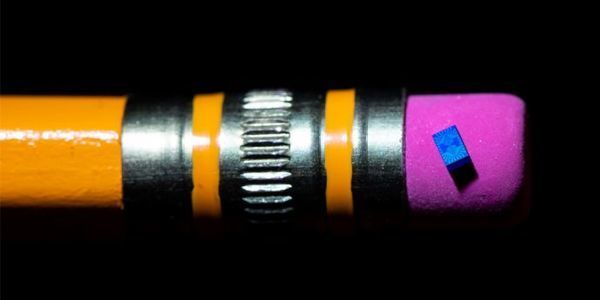
Intel Starts Testing Smallest 'Spin Qubit' Chip for Quantum Computing
"Intel researchers are taking new steps toward quantum computers by testing a tiny new “spin qubit” chip. The new chip was created in Intel’s D1D Fab in Oregon using the same silicon manufacturing techniques that the company has perfected for creating billions of traditional computer chips. Smaller than a pencil’s eraser, it is the tiniest quantum computing chip Intel has made. The new spin qubit chip runs at the extremely low temperatures required for quantum computing: roughly 460 degrees below zero Fahrenheit – 250 times colder than space. The spin qubit chip does not contain transistors – the on/off switches that form the basis of today’s computing devices – but qubits (short for “quantum bits”) that can hold a single electron. The behavior of that single electron, which can be in multiple spin states simultaneously, offers vastly greater computing power than today’s transistors, and is the basis of quantum computing." [...]
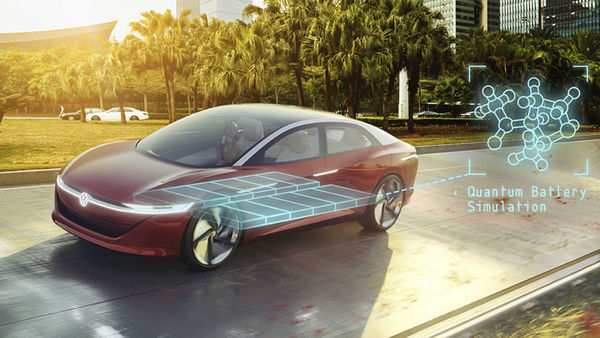
Volkswagen tests quantum computing in battery research
"For the first time, Volkswagen experts have succeeded in simulating industrially relevant molecules using a quantum computer. This is especially important for the development of high-performance electric vehicle batteries. The experts have successfully simulated molecules such as lithium-hydrogen and carbon chains. Now they are working on more complex chemical compounds. In the long term, they want to simulate the chemical structure of a complete electric vehicle battery on a quantum computer. Their objective is to develop a “tailor-made battery”, a configurable chemical blueprint that is ready for production." [...]

Mbed OS 5.8.6 released
"We are pleased to announce the Mbed OS 5.8.6 release is now available. This is the last patch release based on the feature set that Mbed-OS-5.8 introduces. Summary We have updated mbed-coap to version 4.4.4. This fixes a hardfault which was occurring during reconnection retry with Thread. We have fixed an issue with the Cordio BLE stack using the H4 UART transport. The H4 stack was previously calling Serial::writeble() in interrupt context, attempting to obtain a lock on a mutex, which is illegal in this context and was causing the stack to fault." [...]

Let's Give Them Something To Taco 'Bout: Enabling Self-driving Food Delivery With Postmates
"A new Ford Transit Connect self-driving research vehicle features three lockers - one on the passenger side and two in the back - that help deliver both food and goods Ford is working with Postmates - which offers on-demand delivery from restaurants and coffee shops to other types of stores as well - to run a service in that will help us establish a self-driving delivery business that works great for customers and businesses With this pilot, Ford is learning how businesses and restaurants will need to interact with and load a self-driving vehicle, and whether there are any obstacles to overcome. By Alexandra Ford English, Ford Autonomous Vehicle Business Team It’s a familiar feeling. The day inches towards dinner and your stomach makes a simple, direct plea to your heart: You want tacos. That hand pressed corn tortilla, the tangy salsa and fresh cilantro – you’re getting hungry already! But what if ordering tacos did more than just satisfy the gremlin in your gut? What if it actually…shaped the future?" [...]
Ciência e Tecnologia
New laser makes silicon 'sing'
"Yale scientists have created a new type of silicon laser that uses sound waves to amplify light. A study about the discovery appears in the online edition of the journal Science. In recent years, there has been increasing interest in translating optical technologies — such as fiber optics and free-space lasers — into tiny optical or “photonic” integrated circuits. Using light rather than electricity for integrated circuits permits sending and processing information at speeds that would be impossible with conventional electronics. Researchers say silicon photonics — optical circuits based on silicon chips — are one of the leading platforms for such technologies, thanks to their compatibility with existing microelectronics. “We’ve seen an explosion of growth in silicon photonic technologies the past few of years,” said Peter Rakich, an associate professor of applied physics at Yale who led the research." [...]

Scientists go deep to quantify perovskite properties
"Rice University, Los Alamos lead project to study excitons important to next-generation electronics Scientists led by Rice University and Los Alamos National Laboratory have discovered electronic properties in quantum-scale devices that are likely to impact the growing field of low-cost perovskite based optoelectronics. In an open-access Nature Communications paper, researchers led by Los Alamos scientists Aditya Mohite and Jean-Christophe Blancon, both of whom will join Rice this summer, studied the behavior of excitons trapped in quantum wells made of crystalline, halide-based perovskite compounds. As a result, they were able to create a scale by which labs can determine the binding energy of excitons, and thus the band gap structures, in perovskite quantum wells of any thickness. This could in turn aid in the fundamental design of next-generation semiconductor materials. Perovskite quantum well-based optoelectronic devices convert and control light at the quantum scale, reactions below 100 nanometers that follow different rules from those dictated by classical mechanics. Solar cells that turn light into electricity are optoelectronic devices." [...]
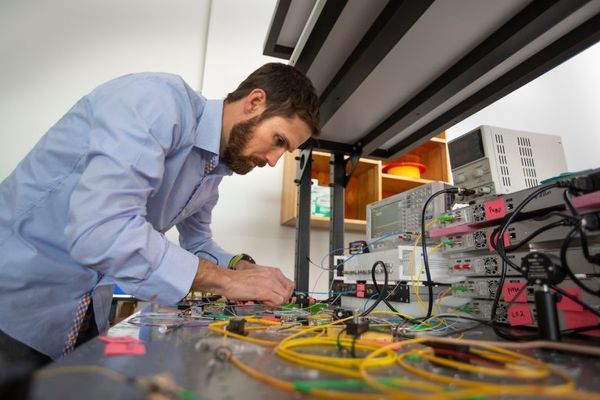
NAU scientist contributes to significant advance in silicon photonics
"Northern Arizona University assistant professor Ryan Behunin collaborated with a team of physicists from Yale and the University of Texas at Austin in discovering an innovative way to manipulate light in silicon. By demonstrating a new type of laser that amplifies light with sound waves in a silicon chip, the team’s research represents a significant advance in the field of silicon photonics. Behunin contributed to the theory and modeling aspects of the project, the results of which were published Thursday in Science. Replacing wires with “waveguides” a potential game-changer for technology Having the ability to manipulate light in silicon could potentially represent a game-changer in computer chip technology. “We’ve invested trillions of dollars in understanding silicon, because that’s the material we use to create computer chips,” Behunin said. “We can control silicon at the atomic level, make wafers of pure crystal silicon and even make a silicon crystal out of atoms that all have the same atomic weight." [...]
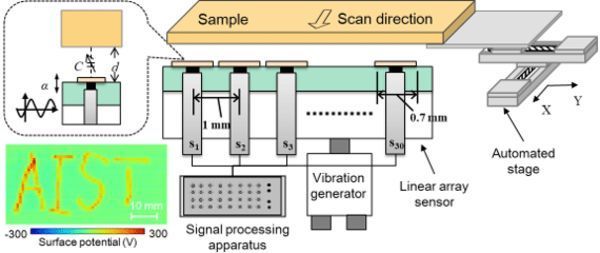
Static Electricity Scanner for Visualizing Surface Potential Distribution
"Summary The researchers have developed a static electricity scanning system which can measure surface potential distribution at a spatial resolution of 1 mm. The system consists of a high-speed signal processing apparatus and a small-sized, high-performance array sensor which is a capacitance type. Method created by AIST The researchers have developed a liner array sensor which comprises 30 parallel microsensors placed at intervals of 1 mm. The sensor has been miniaturized by fabricating the microsensors and the other parts using photolithography technology. They have also developed a high-speed signal processing apparatus. Using the developed array sensor that can measure weak signals and the high-speed processing apparatus, a system with high-speed scanning of an object surface at a speed of 15 mm/s and capable of visualizing distribution of surface potential at a spatial resolution of 1 mm has been developed." [...]

New approach to generating ultrashort pulses
"Extremely short mid-infrared laser pulses will help scientists explore ultrafast processes in atoms A laser synthesizer developed by an A*STAR researcher and his overseas collaborators produces infrared pulses shorter than the wave period, which could enable scientists to probe how electrons move inside atoms and solids. Importantly, these pulses are readily absorbed by many atoms and molecules because their wavelengths lie in the mid-infrared range. Processes within atoms, such as electrons moving from one energy level to another, happen extremely quickly, on time scales of femtoseconds (10−15 second) or even attoseconds (10−18 second). Consequently, researchers need very short, high-power laser pulses to observe these events. One way to generate them is to shine highly intense, ultrashort infrared pulses on to nonlinear crystals. Houkun Liang at A*STAR’s Singapore Institute of Manufacturing Technology and his colleagues in the United States and Germany realized they needed to rethink conventional approaches for generating ultrashort mid-infrared pulses." [...]

NIST's Invention Machine: Making the Perfect Parts
"On a recent morning, Rick Lake stopped in the middle of giving a tour of NIST’s Machine Shop to ponder a part sitting on a shelf. It was about 25 centimeters long and made of metal coated in a sheen of purple and blue. Along the top, gaskets, nuts and bolts stuck out like spines on a steampunk caterpillar. At the top, one big opening poked out like a head. “It’s a manifold made for integrating gasses,” Lake explained, and each opening was supposed to provide an attachment for a nozzle. The dramatic, almost psychedelic color was the result of coating the entire piece, made of stainless steel, in vaporized glass." [...]

Swimming without an engine
"Using nothing but 3D printing, scientists have developed a paddling submarine that requires no engine, propellant or power supply. Researchers at ETH Zurich under the direction of ETH Professor Kristina Shea and colleagues at Caltech in Pasadena, California, have developed a new propulsion concept for swimming robots. The robot exploits temperature fluctuations in the water for propulsion without the need for an engine, propellant or power supply. As a proof-of-concept study, the researchers developed a 7.5-centimetre mini-submarine equipped with paddles, which they fabricated entirely using a multi-material 3D printer. The researchers report on this in the journal PNAS. The paddles are actuated using a bistable propulsion element triggered by two shape memory polymer strips as previously developed by Shea and her doctoral student Tim Chen." [...]
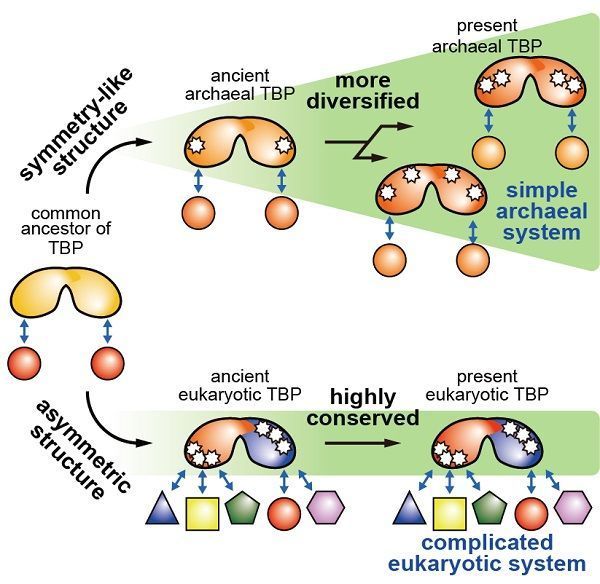
Scientists reveal how eukaryotic transcription systems gained complexity
"New evolutionary indicator helps uncover ancient transcription systems Researchers at the University of Tokyo and their collaborators have revealed for the first time the mechanism by which the system that initiates transcription in eukaryotes gained complexity when organisms in this domain evolved from archaea about 2.5 billion years ago. In studying evolution, scientists generally use fossils to estimate when organisms diverged from their common ancestors. In the field of molecular evolution, researchers look at identical or closely related sequences in DNA and proteins of existing organisms to trace their evolutionary history by applying such methods known as sequence comparison, measurement of evolutionary distance, and phylogenetic analysis. However, these methods have inherent drawbacks: Because genes of ancient organisms can no longer be found, we cannot measure the evolutionary distances, or changes in the genes, between existing organisms and their ancestors. Therefore, the evolutionary process of the whole gene family has never been determined. In a previous study published in 2016, the research group led by Associate Professor Masami Horikoshi of the Institute for Quantitative Biosciences at the University of Tokyo developed a new analytical method for measuring the evolutionary distances between existing and ancestral organisms by focusing on sequences that repeat themselves within a gene." [...]

A nanotech sensor turns molecular fingerprints into bar codes
"Infrared spectroscopy is the benchmark method for detecting and analyzing organic compounds. But it requires complicated procedures and large, expensive instruments, making device miniaturization challenging and hindering its use for some industrial and medical applications and for data collection out in the field, such as for measuring pollutant concentrations. Furthermore, it is fundamentally limited by low sensitivities and therefore requires large sample amounts. However, scientists at EPFL’s School of Engineering and at Australian National University (ANU) have developed a compact and sensitive nanophotonic system that can identify a molecule’s absorption characteristics without using conventional spectrometry. The scientists have already used their system to detect polymers, pesticides and organic compounds. What’s more, it is compatible with CMOS technology." [...]

Controlling chaos in particle accelerators
"The use of particle accelerators is not confined to basic research in high-energy physics. Large-scale accelerators and gigantic devices, such as the Large Hadron Collider (LHC), are used for this purpose, but relatively small accelerators are used in medicine (diagnostic imaging, cancer treatment), industry (food sterilization, cargo scanning, electronic engineering), and various types of investigation (oil prospecting, archeological surveying, analysis of artworks). Whatever the use, controlling chaos and boosting particle flow efficiency are the goals of the scientific community in this field. A paper describing a new contribution in this direction has recently been published in the journal Physics of Plasmas by Meirielen Caetano de Sousa, a postdoctoral researcher with a scholarship from FAPESP working at the University of São Paulo’s Physics Institute (IF-USP) in Brazil, and her supervisor Iberê Luiz Caldas, Full Professor at IF-USP. “We performed a theoretical study with modeling and numerical simulation to investigate ways of controlling chaos inside accelerators and increasing the maximum velocity of accelerated particles,” Sousa told Agência FAPESP. The authors designed a mechanism based on the deployment of a transport barrier to confine the particles and prevent them from moving from one region of the accelerator to another." [...]

Lead-free, Efficient Perovskite for Photovoltaic Cells
"A KAIST research team has proposed a perovskite material, Cs2Au2I6 that serves as a potential active material for highly efficient lead-free thin-film photovoltaic devices. This material is expected to lay the foundation to overcome previously known limitations of perovskite including its stability and toxicity issues. As strong candidates for next-generation high-efficiency photovoltaic cells, perovskite photovoltaic cells have a maximum photoconversion efficiency of 22%, comparable to high-performance crystalline silicon photovoltaic cells. In addition, perovskite-based cells can be fabricated at low temperatures, thereby bringing about dramatic cost reductions. However, it has been noted that conventional organic-inorganic hybrid perovskite materials exhibit low stability, eventually degrading their performance and making them unfit for continued use. Moreover, their inclusion of lead has undermined their environmental friendliness." [...]
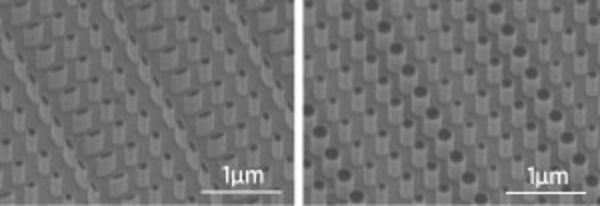
Light-bending nano-patterns for LEDs
"Direct nanoscale patterning of LED surfaces brings new possibilities for the control of light Nanoscale patterns designed to bend, deflect and split light can now be fabricated directly on light-emitting diode (LED) surfaces using an innovative etching method developed by A*STAR researchers1. The new fabrication scheme creates new possibilities for the facile control of light output. Recent advancements in LED lighting have transformed daily life and cutting-edge technology — from efficient room lighting, to TV and mobile device backlights, and the tiny optical circuits that drive global fiber-optic networks. The light-emitting component of LEDs is a surprisingly simple structure, typically a thin layer of a dielectric material such as gallium nitride (GaN) on a crystalline sapphire substrate. This structure means the light emitted by LEDs is inefficiently dispersed in all directions, including back into the substrate on which the light-emitting layer is fixed. So, while researchers have made tremendous advances in light-emitting efficiency, there remains room for improvement." [...]
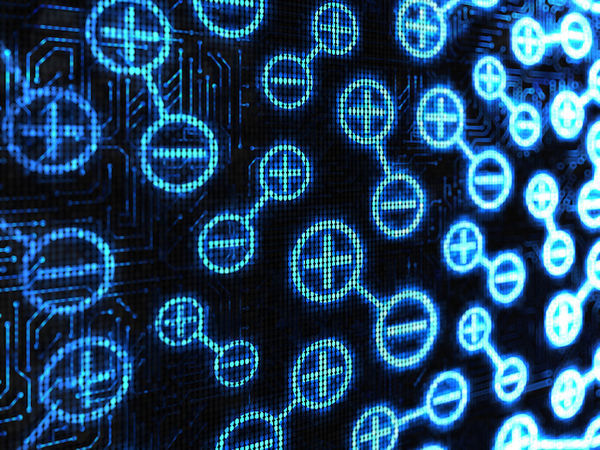
Electrons Take One Step Forward Without Two Steps Back
"Scientists use molecular dipoles to accelerate electron transfer in one direction and completely suppress it in the other. This “holy grail” of energy science could hasten the design of new and superb energy and electronic materials. Researchers at the University of California, Riverside, have, for the first time, successfully used electric dipoles to completely suppress electron transfer in one direction while accelerating in the other. The discovery could aid development of improved solar cells and other energy-conversion devices and hasten the design of new and superb energy and electronic materials. It is not a stretch to say that life depends on strictly regulated electron transfer. Electron transfer is among the most fundamental processes for sustaining life and for energy conversion." [...]

The quantum choreographer
"Using diamond dust and laser light to control atomic spin, Ashok Ajoy PhD ’16 pursues alternatives to costly conventional imaging technologies. Listening to Ashok Ajoy PhD ’16 talk about his work, it’s easy to forget he’s a physicist. “I make spins dance together, go up or down, interact, in a kind of spin choreography,” he says. Ajoy unleashes his creativity not on human bodies but on elementary particles, manipulating quantum behavior, and specifically, spin — the property of angular momentum intrinsic to such entities as atomic nuclei. After doctoral research at MIT generating insights on spin and novel methods for maneuvering quantum mechanical objects, Ajoy is now pioneering technologies with the potential to transform the fields of imaging and chemical analysis. Using diamond dust, laser light, and water, Ajoy and his colleagues at the University of California at Berkeley are pursuing alternatives to the multi-million dollar, room-size machines in current use." [...]

Rutgers Physicists Create New Class of 2D Artificial Materials
"International team verifies 53-year-old theory on ferroelectric metals; findings could spawn a new generation of multi-functional devices and applications In 1965, a renowned Princeton University physicist theorized that ferroelectric metals could conduct electricity despite not existing in nature. For decades, scientists thought it would be impossible to prove the theory by Philip W. Anderson, who shared the 1977 Nobel Prize in physics. It was like trying to blend fire and water, but a Rutgers-led international team of scientists has verified the theory and their findings are published online in Nature Communications. “It’s exciting,” said Jak Chakhalian, a team leader of the study and Professor Claud Lovelace Endowed Chair in Experimental Physics at Rutgers University–New Brunswick. “We created a new class of two-dimensional artificial materials with ferroelectric-like properties at room temperature that don’t exist in nature yet can conduct electricity. It’s an important link between a theory and an experiment.” A cornerstone of technology, ferroelectric materials are used in electronics such as cell phone and other antennas, computer storage, medical equipment, high precision motors, ultra-sensitive sensors and sonar equipment." [...]
Silicon provides means to control quantum bits for faster algorithms
"Researchers are taking advantage of a newly found phenomenon in silicon that makes quantum bits easier to manipulate, leading to faster and longer-lived information processing via quantum computing. (Purdue University image/Rifat Ferdous) Quantum bits are now easier to manipulate for devices in quantum computing, thanks to enhanced spin-orbit interaction in silicon. A silicon quantum computer chip has the potential to hold millions of quantum bits, or qubits, for much faster information processing than with the bits of today’s computers. This translates to high-speed database searches, better cybersecurity and highly efficient simulation of materials and chemical processes. Now, research groups from Purdue University, the Technological University of Delft, Netherlands and the University of Wisconsin-Madison have discovered that silicon has unique spin-orbit interactions that can enable the manipulation of qubits using electric fields, without the need for any artificial agents. “Qubits encoded in the spins of electrons are especially long-lived in silicon, but they are difficult to control by electric fields." [...]
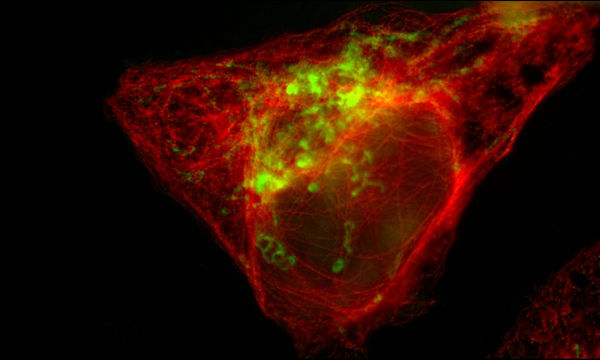
Beyond colour in cellular microscopy
"A new microscopy technique developed at RMIT allows researchers to see more of what’s happening inside cells. The new “bleaching-assisted multichannel microscopy” (BAMM) technique improves the quantity of information captured in fluorescence microscopy. This will allow researchers to better observe protein and molecule interactions in a wide range of health-related research. The technique was developed by a team led by RMIT University’s Dr Antony Orth, a Research Fellow with the Australian Research Council’s Centre of Excellence for Nanoscale BioPhotonics (CNBP). Fluorescence microscopy, where light-emitting “fluorophore” molecules are used to label proteins or other cellular targets, is one of the most widely used techniques in biology. “When a fluorophore is excited by light, it reacts by emitting a specific colour signature,” Orth says." [...]
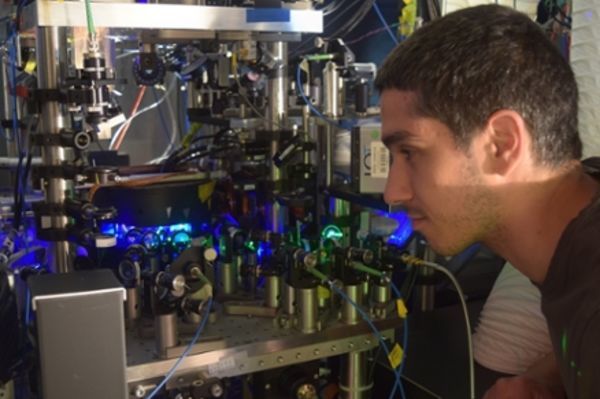
Quantum LEGO: building ultracold molecules
"Physicists dream of having a rich supply of ultracold molecules with specific electronic properties. A dense gas of such particles would have exciting applications in tests of fundamental physics, quantum-controlled chemistry and the study of many-body systems. Researchers at the University of Amsterdam, together with colleagues from Poland and the UK, have now made a breakthrough that will allow them to build molecules out of strontium and rubidium at temperatures only one millionth of a degree above the absolute zero temperature. Their results were published in Nature Physics this week. Cooling matter is not easy. Atoms and molecules have the tendency to jump around, to rotate and to vibrate." [...]

Realization of high-performance magnetic sensors due to magnetic vortex structures
"Magnetic sensors play a key role in a variety of applications, such as speed and position sensing in the automotive industry or in biomedical applications. Within the framework of the Christian Doppler Laboratory "Advanced Magnetic Sensing and Materials" headed by Dieter Süss novel magnetic sensors have been realized that surpass conventional technologies in performance and accuracy in a cooperation between the University of Vienna, the Danube University Krems and Infineon AG. The researchers present the new development in the latest issue of the journal "Nature Electronics". Many modern technological applications are based on magnetic forces, e.g. to move components in electric vehicles or to store data on hard disks. Yet magnetic fields are also used as sensors to detect other magnetic fields." [...]
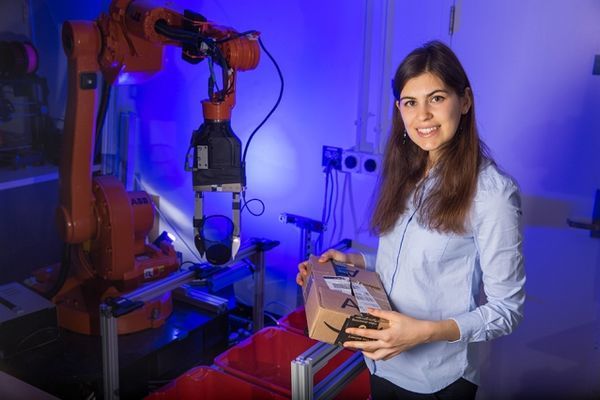
Teaching robots how to move objects
"PhD candidate and Amazon Robotics Challenge winner Maria Bauza helps to improve how robots interact with the world. With the push of a button, months of hard work were about to be put to the test. Sixteen teams of engineers convened in a cavernous exhibit hall in Nagoya, Japan, for the 2017 Amazon Robotics Challenge. The robotic systems they built were tasked with removing items from bins and placing them into boxes. For graduate student Maria Bauza, who served as task-planning lead for the MIT-Princeton Team, the moment was particularly nerve-wracking. “It was super stressful when the competition started,” recalls Bauza." [...]

Making Quantum Puddles
"UVM physicists discover how to create the thinnest liquid films ever A team of physicists at the University of Vermont have discovered a fundamentally new way surfaces can get wet. Their study may allow scientists to create the thinnest films of liquid ever made—and engineer a new class of surface coatings and lubricants just a few atoms thick. “We've learned what controls the thickness of ultra-thin films grown on graphene,” says Sanghita Sengupta, a doctoral student at UVM and the lead author on the new study. “And we have a good sense now of what conditions—like knobs you can turn—will change how many layers of atoms will form in different liquids.” The results were published June 8 in the journal Physical Review Letters. A third way To understand the new physics, imagine what happens when rain falls on your new iPhone: it forms beads on the screen. They’re easy to shake off." [...]
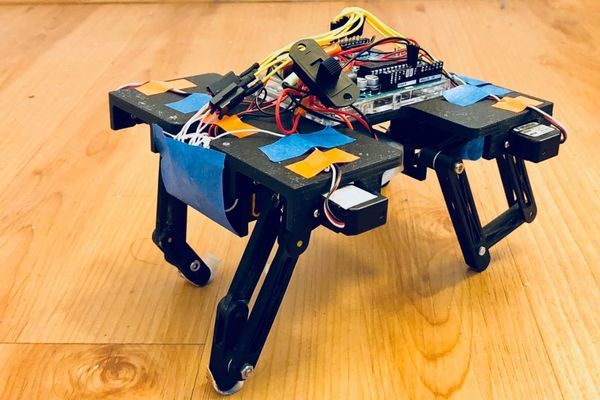
How to build a robot that mimics the moves of animals - and why you'd want to
"Inspired by nature, students create creaturelike robots that could improve security, explore disaster sites and even save lives From slithering and walking to flying or swimming, animals are able to move and interact with their environment with relative ease. However, building a robot with the same capabilities is much more difficult. “Roboticists watch creatures in the natural world with a great deal of envy,” said Satyandra “S.K.” Gupta, who holds a Smith International Professorship in Mechanical Engineering at the USC Viterbi School of Engineering. “Taking inspiration from nature offers new possibilities for realizing novel robots. As such, bio-inspired robotics has emerged as an important specialization within the field of robotics,” said Gupta, associate department chair for the Department of Aerospace and Mechanical Engineering and director of the Center for Advanced Manufacturing. By mimicking natural movements, these creaturelike robots can go where traditional robots cannot, such as the difficult terrain of disaster sites." [...]
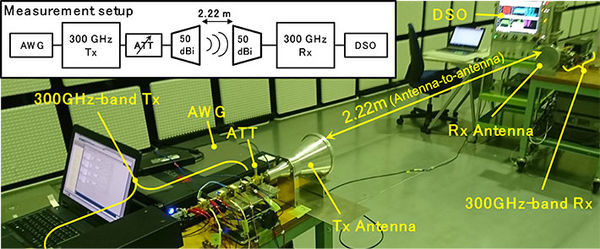
Ultra high-speed IC capable of wireless transmission of 100 gigabits per second in a 300 GHz band
"Technology expected to pioneer utilization of unexplored terahertz wave frequencies Nippon Telegraph and Telephone Corporation (NTT; head office: Chiyoda-ku, Tokyo; president & CEO: Hiroo Unoura), and Tokyo Institute of Technology (Tokyo Tech; head office: Meguro-ku, Tokyo; president: Kazuya Masu), have jointly developed an ultra high-speed IC for wireless front-end that operates on a terahertz frequency band, and in the 300 GHz band they have succeeded in developing the world's fastest 100 gigabit per second wireless transmission data rate. It is expected that unused terahertz waves can be applied to high-speed wireless transmission since a wide frequency band can be secured. In this research, we implemented a mixer circuit that applied a unique proprietary high isolation design technology with an Indium phosphide high electron mobility transistor (InP-HEMT). This enlarged the transmission bandwidth, which is a problem in the conventional 300 GHz band wireless front end. It also improved the signal-to-noise ratio (SNR). In addition, using this we realized a 300 GHz band wireless front-end module, and we achieved wireless transmission of 100 Gbps (gigabits per second)." [...]

E-textiles control home appliances with the swipe of a finger (video)
"“Screen-Printed Washable Electronic Textiles as Self-Powered Touch/Gesture Tribo-Sensors for Intelligent Human-Machine Interaction” Electronic textiles could allow a person to control household appliances or computers from a distance simply by touching a wristband or other item of clothing — something that could be particularly helpful for those with limited mobility. Now researchers, reporting in ACS Nano, have developed a new type of e-textile that is self-powered, highly sensitive and washable. A video of an e-wristband in action is available here. E-textiles are not new, but most existing versions have poor air permeability, can’t be laundered or are too costly or complex to mass-produce. Jiaona Wang, Hengyu Guo, Congju Li and coworkers wanted to develop an E-textile that overcomes all of these limitations and is highly sensitive to human touch. The researchers made a self-powered triboelectric nanogenerator by depositing an electrode array of conductive carbon nanotubes on nylon fabric." [...]
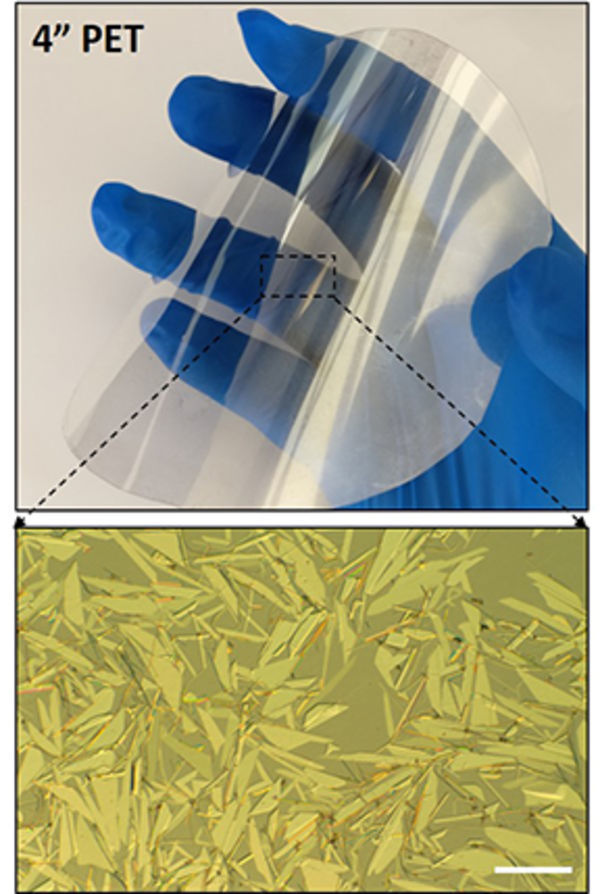
New 2-dimensional nanomaterial shows promise for high-speed electronics, defense tools and biochemical detection devices
"Purdue University researchers have discovered a two-dimensional nanomaterial derived from the rare element tellurium that may change how infrared technology is used in national defense tools, surveillance equipment, high-performance electronics and biochemical detection devices. The researchers created the nanomaterial, which they called tellurene, in a solution. The material has a thin, durable structure with unique properties. “We can build this material atom-by-atom and scale it up for many different uses,” said Wenzhuo Wu, an assistant professor in Purdue’s School of Industrial Engineering, who worked on the team that discovered tellurene. “Our material is superior to other two-dimensional materials such as black phosphorous because we have a high production yield and tellurene is air-stable. Tellurene can grow on its own without the help of another substance, which makes it different than those other materials.” Tellurium is not abundant on the Earth’s crust, but Wu said only a tiny amount is needed to be synthesized through their solution method." [...]
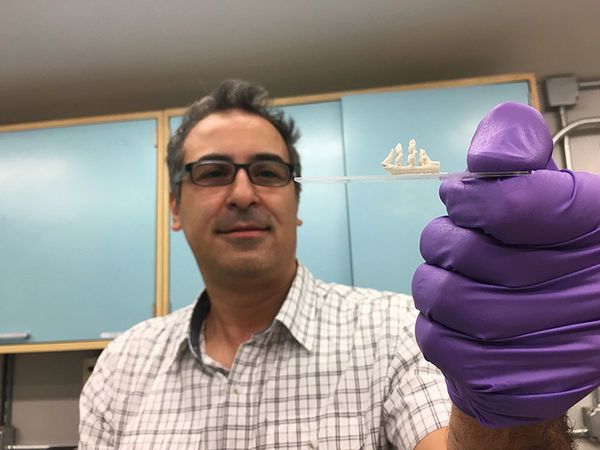
Now you can 3D print clay, cookie dough - or solid rocket fuel
"It's now possible to 3D print extremely viscous materials, with the consistency of clay or cookie dough with fine precision, thanks to work done at Purdue University. This development may soon allow the creation of customized ceramics, solid rockets, pharmaceuticals, biomedical implants, foodstuffs, and more. "It’s very exciting that we can print materials with consistensies that no one’s been able to print." says Emre Gunduz, assistant research professor in the School of Mechanical Engineering. "We can 3D print different textures of food; biomedical implants, like dental crowns made of ceramics, can be customized. Pharmacies can 3D print personalized drugs, so a person only has to take one pill, instead of 10."" [...]
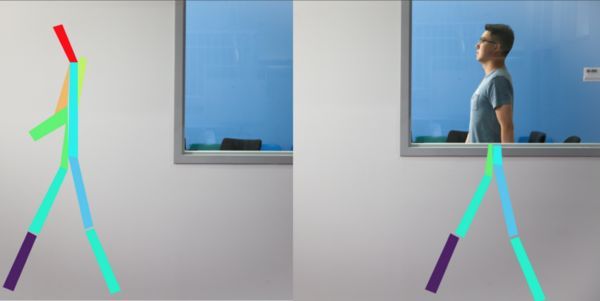
Artificial intelligence senses people through walls
"Wireless smart-home system from the Computer Science and Artificial Intelligence Laboratory could monitor diseases and help the elderly “age in place.” X-ray vision has long seemed like a far-fetched sci-fi fantasy, but over the last decade a team led by Professor Dina Katabi from MIT’s Computer Science and Artificial Intelligence Laboratory (CSAIL) has continually gotten us closer to seeing through walls. Their latest project, “RF-Pose,” uses artificial intelligence (AI) to teach wireless devices to sense people’s postures and movement, even from the other side of a wall. The researchers use a neural network to analyze radio signals that bounce off people’s bodies, and can then create a dynamic stick figure that walks, stops, sits, and moves its limbs as the person performs those actions. The team says that RF-Pose could be used to monitor diseases like Parkinson’s, multiple sclerosis (MS), and muscular dystrophy, providing a better understanding of disease progression and allowing doctors to adjust medications accordingly. It could also help elderly people live more independently, while providing the added security of monitoring for falls, injuries and changes in activity patterns. The team is currently working with doctors to explore RF-Pose’s applications in health care." [...]

NIF achieves record double fusion yield
"An experimental campaign conducted at Lawrence Livermore National Laboratory’s (LLNL) National Ignition Facility (NIF) has achieved a total fusion neutron yield of 1.9e16 (1.9x1016) and 54 KJ of fusion energy output -- double the previous record. Researchers in LLNL’s Inertial Confinement Fusion Program (ICF) detail the results in a paper that will be published this week in Physical Review Letters. NIF is the world’s largest and most energetic laser, designed to perform experimental studies of fusion ignition and thermonuclear burn, the phenomenon that powers the sun, stars and modern nuclear weapons. As a key component of the National Nuclear Security Administration’s Stockpile Stewardship Program, experiments fielded on NIF enable researchers to gain fundamental understanding of extreme temperatures, pressures and densities -- knowledge that helps ensure the current and future nuclear stockpile is safe and reliable. The record-breaking experiments utilized a diamond capsule -- a layer of ultra-thin high-density carbon containing the deuterium-tritium (DT) fusion fuel -- seated inside a depleted uranium hohlraum. This approach allowed the researchers to greatly improve their control over the symmetry of the X-rays that drive the capsule, producing “rounder” and more symmetric implosions." [...]
Silicon-Perovskite Solar Cells Achieve Record Efficiency of 25,2%
"In the field of photovoltaic technologies, silicon-based solar cells make up 90% of the market. In terms of cost, stability and efficiency (20-22% for a typical solar cell on the market), they are well ahead of the competition. However, after decades of research and investment, silicon-based solar cells are now close to their maximum theoretical efficiency. As a result, new concepts are required to achieve a long-term reduction in solar electricity prices and allow photovoltaic technology to become a more widely adopted way of generating power. One solution is to place two different types of solar cells on top of each other to maximize the conversion of light rays into electrical power. These “double-junction” cells are being widely researched in the scientific community, but are expensive to make." [...]

Army scientists have a blast with aluminum nanoparticles
"Army scientists proved a decades-old prediction that mixing TNT and novel aluminum nanoparticles can significantly enhance energetic performance. This explosive discovery is expected to extend the reach of U.S. Army firepower in battle. Researchers from the U.S. Army Research Laboratory and Texas Tech University demonstrated up to 30-percent enhancement in the detonation velocity of the explosive TNT by adding novel aluminum nanoparticles in which the native alumina shell has been replaced with an oxidizing salt called AIH, or aluminum iodate hexahydrate. The structure of the AIH-coated aluminum nanoparticles was revealed for the very first time through high resolution transmission electron (TEM) microscopy performed by ARL's Dr. Chi-Chin Wu, a materials researcher who leads the plasma research for the lab's Energetic Materials Science Branch in the Lethality Division of Weapons and Materials Research Directorate. Wu said this revolutionary research offers the potential for the exploitation of aluminum and potentially other metallic nanoparticles in explosive formulations to extend the range and destructive power of Army weapons systems, a key objective of the Army's "Long Range Precision Fires" modernization priority. "We believe these results show tremendous promise for enhancing the detonation performance of conventional military explosives with aluminum nanoparticles for the first time," said ARL's Dr. Jennifer Gottfried, a physical chemist who collaborated on the research." [...]
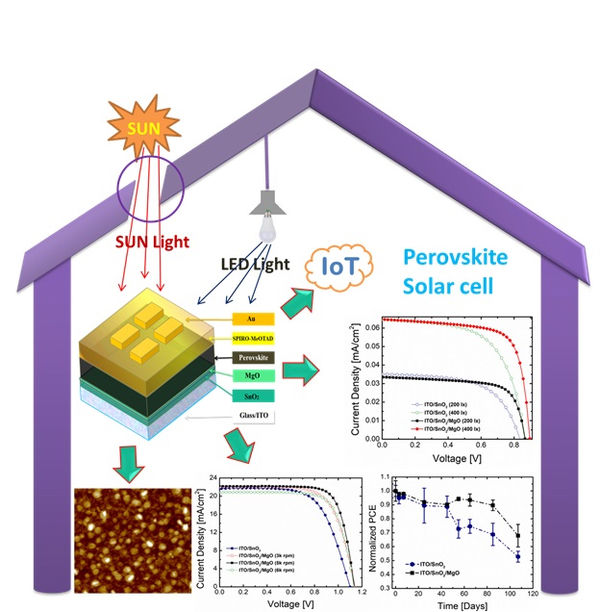
Perovskite Solar Cell Technology for Exceptional Light Harvesting Under Indoor Illumination
"Perovskite solar cells have been attracting great attention from the scientific and industrial communities in the past few years because they are able to combine high power conversion efficiencies under standard test conditions (i.e. those of the sun) with simple manufacturing processes. The films that make up the cells are in fact cast from solution (i.e. printed via inks) or evaporated over large areas. Franco Cacialli, Professor of Physics in the London Centre for Nanotechnology and the Department of Physics and Astronomy at UCL, in collaboration with researchers at the Centre for Hybrid and Organic Solar Energy (CHOSE), Department of Electronic Engineering University of Rome – Tor Vergata, have developed perovskite solar cells with maximum power density under white LED illumination of 20.2 µW/cm2 at 200 1x and 41.6 µW/cm2 at 400 1x (corresponding to a power conversion of 27%). The authors of the work believe these to be the highest power output densities ever reported under illumination conditions typically found in homes and offices." [...]

Turbocharge for Lithium Batteries
"A team of material researchers from Jülich, Munich, and Prague has succeeded in producing a composite material that is particularly suited for electrodes in lithium batteries. The nanocomposite material might help to significantly increase the storage capacity and lifetime of batteries as well as their charging speed. The researchers have published their findings in the journal Advanced Functional Materials. Lithium-ion batteries are the ultimate benchmark when it comes to mobile phones, tablet devices, and electric cars. Their storage capacity and power density are far superior to other rechargeable battery systems. Despite all the progress that has been made, however, smartphone batteries only last a day and electric cars need hours to be recharged." [...]

A Better Device for Measuring Electromagnetic Radiation
"New bolometer is faster, simpler, and covers more wavelengths. Bolometers, devices that monitor electromagnetic radiation through heating of an absorbing material, are used by astronomers and homeowners alike. But most such devices have limited bandwidth and must be operated at ultralow temperatures. Now, researchers say they’ve found a ultrafast yet highly sensitive alternative that can work at room temperature — and may be much less expensive. The findings, published today in the journal Nature Nanotechnology, could help pave the way toward new kinds of astronomical observatories for long-wavelength emissions, new heat sensors for buildings, and even new kinds of quantum sensing and information processing devices, the multidisciplinary research team says. The group includes recent MIT postdoc Dmitri Efetov, Professor Dirk Englund of MIT’s Department of Electrical Engineering and Computer Science, Kin Chung Fong of Raytheon BBN Technologies, and colleagues from MIT and Columbia University." [...]
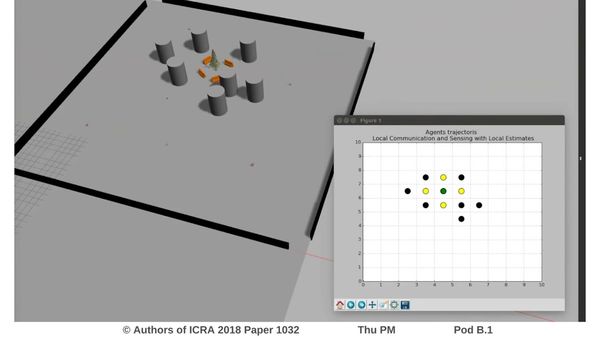
Robots learn by checking in on team members
"Innovative drone designs and software enables a team of drones to work together in a coordinated approach. The software and hardware needed to co-ordinate a team of unmanned aerial vehicles (UAVs) that can communicate and work toward a common goal have recently been developed by KAUST researchers. “Giving UAVs more autonomy makes them an even more valuable resource,” says Mohamed Abdelkader, who worked on the project with his colleagues under the guidance of Jeff Shamma. “Monitoring the progress of a drone sent out on a specific task is far easier than remote-piloting one yourself. A team of drones that can communicate among themselves provides a tool that could be used widely, for example, to improve security or capture images simultaneously over a large area.” The researchers trialed a capture the flag game scenario, whereby a team of defender drones worked together within a defined area to intercept an intruder drone and prevent it from reaching a specific place. To give the game more authenticity, and to check if their algorithms would work under unpredictable conditions, the intruder drone was remote-piloted by a researcher." [...]

A new way for designing electronics
"A team from the University of Southampton has invented a new way for designing electronic systems that incorporates the best from both analogue and digital paradigms. The approach combines the computational power of analogue with the energy benefits of digital technologies. This new model alters the current way of thinking and is destined to shape the next generation of electronics. The study, titled ‘Seamlessly fused digital-analogue reconfigurable computing using memristors’, was published in Nature Communications. It revealed how the fusion of analogue and digital thinking can be achieved by combining standard digital electronics - as found in every computer and mobile phone today - with the rapidly emerging technology of analogue memristor devices. This powerful combination is a significant stepping-stone towards the next generation of ultra-low power, high battery life and adaptable electronics." [...]
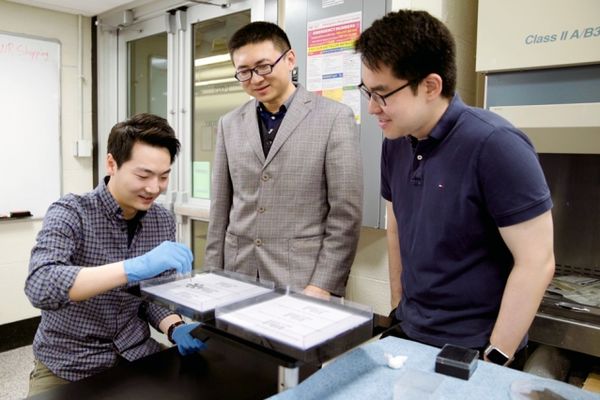
Magnetic 3-D-printed structures crawl, roll, jump, and play catch
"New printing technique could be used to develop remotely controlled biomedical devices. MIT engineers have created soft, 3-D-printed structures whose movements can be controlled with a wave of a magnet, much like marionettes without the strings. The menagerie of structures that can be magnetically manipulated includes a smooth ring that wrinkles up, a long tube that squeezes shut, a sheet that folds itself, and a spider-like “grabber” that can crawl, roll, jump, and snap together fast enough to catch a passing ball. It can even be directed to wrap itself around a small pill and carry it across a table. The researchers fabricated each structure from a new type of 3-D-printable ink that they infused with tiny magnetic particles. They fitted an electromagnet around the nozzle of a 3-D printer, which caused the magnetic particles to swing into a single orientation as the ink was fed through the nozzle." [...]
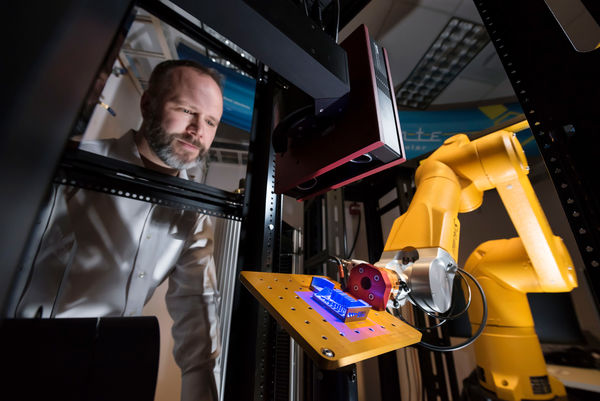
Sandia's robotic work cell conducts high-throughput testing 'in an instant'
"Automation speeds up 3D-printed part testing, materials science data collection Today with 3D printing you can make almost anything in a matter of hours. However, making sure that part works reliably takes weeks or even months. Until now. Sandia National Laboratories has designed and built a six-sided work cell, similar to a circular desk, with a commercial robot at its center that conducts high-throughput testing to quickly determine the performance and properties of the part. They call this flexible, modular and scalable system Alinstante, Spanish for “in an instant.” Sandia is seeking industry partners to help expand or discover more uses for the new robotic testing system. The technology to speed up qualification and testing was the result of Sandia materials scientist Brad Boyce’s challenge in the spring of 2015." [...]
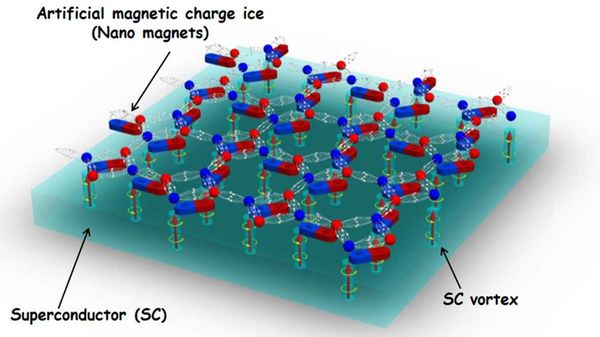
Designing a better superconductor with geometric frustration
"Superconductors contain tiny tornadoes of supercurrent, called vortex filaments, that create resistance when they move. This affects the way superconductors carry a current. But a magnet-controlled “switch” in superconductor configuration provides unprecedented flexibility in managing the location of vortex filaments, altering the properties of the superconductor, according to a new paper in Nature Nanotechnology. “We work on superconductors and how to make them better for applications,” said Boldizsár Jankó, professor in the Department of Physics at the University of Notre Dame and co-corresponding author on the paper. “One of the major problems in superconductor technology is that most of them have these filaments, these tiny tornadoes of supercurrent. When these move, then you have resistance.” Researchers have been trying to design new devices and new technologies to “pin,” or fasten, these filaments to a specified position." [...]

MIT engineers configure RFID tags to work as sensors
"Platform may enable continuous, low-cost, reliable devices that detect chemicals in the environment. These days, many retailers and manufacturers are tracking their products using RFID, or radio-frequency identification tags. Often, these tags come in the form of paper-based labels outfitted with a simple antenna and memory chip. When slapped on a milk carton or jacket collar, RFID tags act as smart signatures, transmitting information to a radio-frequency reader about the identity, state, or location of a given product. In addition to keeping tabs on products throughout a supply chain, RFID tags are used to trace everything from casino chips and cattle to amusement park visitors and marathon runners. The Auto-ID Lab at MIT has long been at the forefront of developing RFID technology." [...]
Documentação
A documentação é parte essencial do processo de aprendizagem e a Internet além de artigos interessantes de explorar também tem alguma documentação em formato PDF interessante de ler. Todos os links aqui apresentados são para conteúdo disponibilizado livremente pelo editor do livro.

newelectronics 12 Junho 2018
"New Electronics is a fortnightly magazine focusing on technological innovation, news and the latest developments in the electronics sector. Downloadable as a digital page turner or pdf file, or offered as a hard copy, the New Electronics magazine is available in a format to suit you. " [...]
Projetos Maker
Diversos Projetos interessantes.
ESP 8266 Nodemcu Ws 2812 Neopixel Based LED MOOD Lamp Controlled Using Webserver
"In this Project we'll make a MOOD Lamp from nodemcu & neopixel and which can be controlled by any browser using local webserver. Hello guys in this instructables i made MOOD LAMP based on Neopixel LED Ring with Nodemcu ESP 8266 and the Lamp is controlled by webserver hosted by nodemcu on the device. So the basic idea to is create a web server by nodemcu and to access that local web server by phone/PC browser & then sending commands by that page to control Neopixels LED by that local web server & light up the Lamp in different colors with different brightness by sending commands from the interface hosted by local web server and there are different modes to see different pattern lights , so enjoy making your own neopixel based web server controlled MOOD LAMP" [...]

Bioinspired Robotic Snake
"I was inspired to begin this project after seeing research videos of both tree climbing robotic snakes and robotic eels. This is my first attempt and building robots using serpentine locomotion, but it won't be my last! Subscribe on YouTube if you would like to see future developments. Below I outline the construction of 2 different snakes along with the files for 3D printing and a discussion about the code and algorithms to achieve snake-like motion. If you wish to continue learning more, after reading this instructable I would suggest reading the links in the references section at the bottom of the page. This instructable is technically a 2-in-1, in that I explain how to make 2 different versions of a robotic snake." [...]
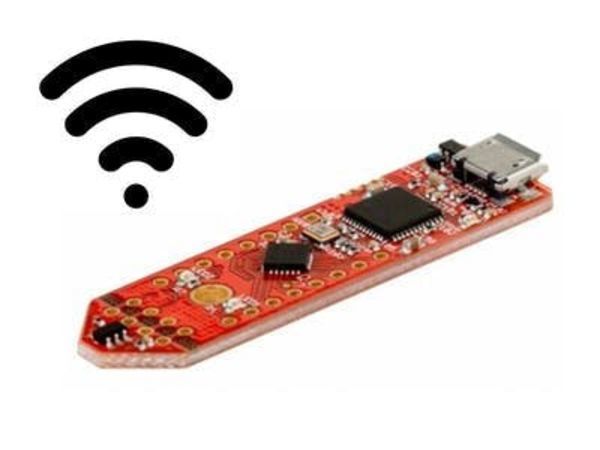
Wireless Magnetic Data Transfer
"Using a 3D magnetic sensor and an electromagnet, this project enables you to transfer data via magnetic fields. Story If you want to send data wirelessly, you have a plethora of options to choose from. From WiFi to BLE to LoRa radio, there's one for every occasion. However, if you want a solution that does not use radio waves, then this is the project for you! " [...]

Candy Tosser
"This "talking, watching, listening" candy dispenser is triggered by the code word, "Alexa." When "Alexa" is heard, the Adafruit sound board requests, "If you want candy, smile NOW!" The Google AIY vision kit watches for a smile. If there is no smile, the sound board says, "No smile, no candy." If there is a smile, candy is dropped onto the catapult, aimed and flung toward the requestor (direction is determined by "where Alexa heard sound from." An Arduino Uno monitors Alexa (Amazon Echo Dot), Google AIY vision, Adafruit sound and four servo motors." [...]

IOT123 - I2C Heartbeat Brick
"The IOT123 BRICKS are DIY modular units that can be mashed up with other IOT123 BRICKS, to add functionality to a node or wearable. They are based on the inch square, double-sided protoboards with interconnected through holes. A number of these BRICKS are expected to be on multiple nodes (Master MCUs - ESP8266 or ATTINY84) on a site. The MCU needs no prior knowledge of the sensors purpose or software needs. It scans for I2C nodes then requests a property dump (sensor data) from each slave. These BRICKs supply 5.0V, 3.3V and another AUX line which is customizable." [...]
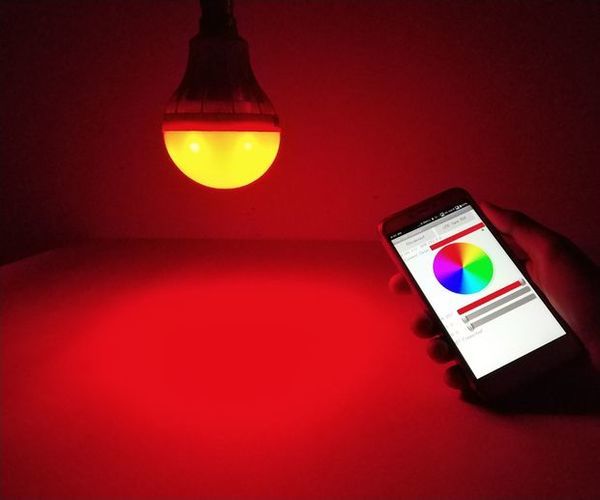
DIY RGB Smart Bulb From Scratch
"Hello Guys, In this instructable, I am going to show you how you can convert your old or broken led bulb into a smartphone-controlled colour changing smart led bulb. So let's get started :) Here's the complete tutorial and demo video. " [...]

Cryptocurrency Ticker
"Due to the popularity of the Reddit post (link), I have decided to put together a tutorial for my crypto-ticker. DISCLAIMER: I am by no means a software or computer engineer (as will be evident when you view my code) so PLEASE make edits where you see fit! This project is written by a beginner, for beginners! All of my pictures show the finished product, not the build process, so I will try to make my language as descriptive as possible. Description: This project uses a Raspberry Pi Zero W and a 16x2 LCD display to show live prices of cryptocurrency from Cryptocompare's API and 24-hour date/time. " [...]

E-Ink Display for Daily News, Weather and More
"A 7.5" e-ink display for displaying useful information such as news, weather, crypto prices, tube status and word of the day. Story Introduction E-ink is a fascinating technology due to its low power properties. Being able render an image to a screen and keep in there indefinitely without power is a powerful thing with infinite possibilities. The motivation for this project came initially from a simple desire to work with e-ink. The idea for the project came a little later. I wanted something that could sit in a central location in my flat and persistently display useful information." [...]
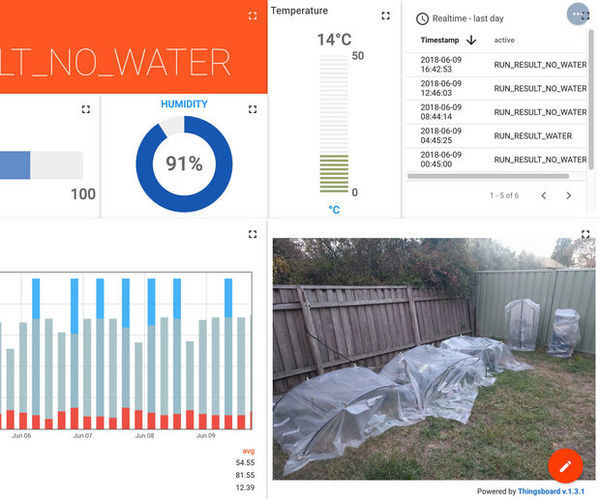
DIY - Automated Garden Irrigation - (Arduino / IOT)
"This project will show you how to build an irrigation controller for a home garden. Capable of measuring soil moisture readings and activating irrigation from a garden tap if the soil becomes too dry. The controller also includes a temperature and humidity sensor. The controller will not activate the garden tap if the temperature is too low. Sensor readings and statistics about water usage / run times are recorded on ThingsBoard IOT for visualisation and analytics. Alerts and emails are triggered if the irrigation controller stops transmitting data, the soil becomes too dry or too saturated." [...]
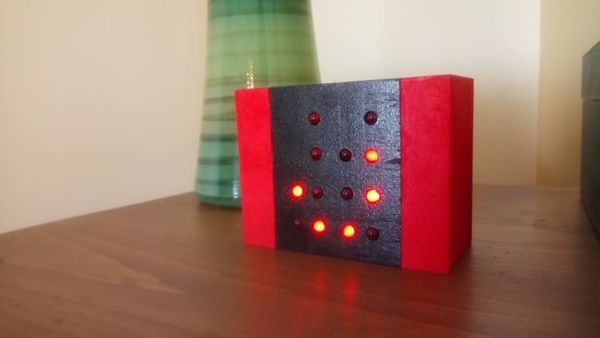
Simple Binary Clock Using Attiny85
"Greetings!In this instructables I show how to make a minimalist and simple binary clock using an arduino uno and a attiny85.If you never used your arduino to program other microchips, you'll see it's very easy to do (I tried it for the first time for this project and it was quite simple) and pretty handy as you can shrink the size of your projects! " [...]

FireBlinks Programmable RGB LED Shoes
"The DIY Light-Up fire blinks kicks are high top sneakers embedded with WS2812 Addressable LED with attiny85 Microcontroller. The LEDs are easily programmable and re-programmable for countless customizations of color can produce upto 16 million colour combinations DAZZLING COLORS IGNITE WHEN YOU WALK, STEP OR BOOGIE. " [...]
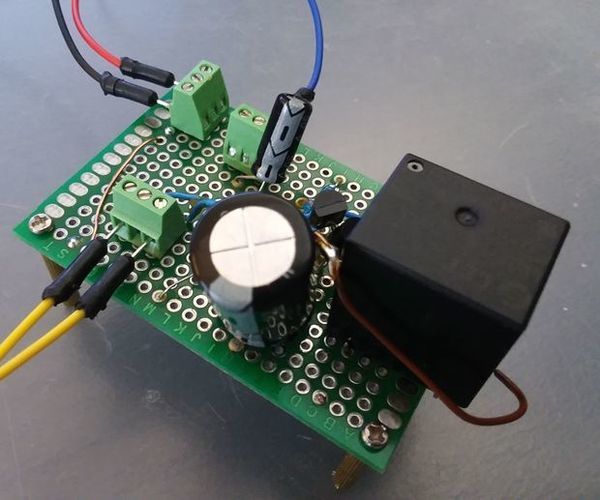
An Emergency-Stop Circuit for a Mobile Robot
"So you've built a robot. Let's say that it's your second one. Typically, we buy a complete one as a kit, for instance, maybe a Smart Video Car from Sunfounder. We had fun building it, rolling it around. But our developing dreams are growing and we soon realize that most of these type kits are really not much more than toys. So we want to move up." [...]

Wallace the Autonomous Talking Robot Valet
"The lofty goal (for me, anyway) was to make a mobile autonomous robot that could sense its surroundings, learn the layout of the home, respond to verbal instructions, and recognize/identify images. And more as time goes on. Also included would be the usual - a remote-controlled robot with a camera. There are many different directions one can take with this project, but it all begins with either building a platform from scratch, where you have to decide the materials, the structure, the motors, and so on, - or - selecting a robot platform where a lot of that work and thought has already been done successfully. There are various mobile robot designs. For example, I could have chosen more of a Mars-rover type with the six motorized wheels and independent movement." [...]
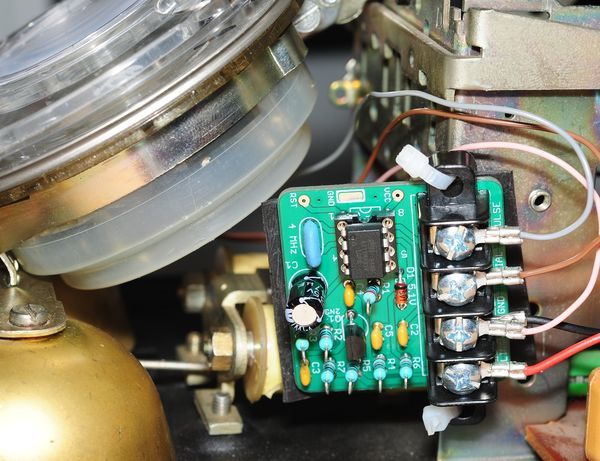
Building your own pulse to tone converter
"A few months ago I purchased a Rotatone module for one of my vintage telephones. It’s a great product, but in the event that you find something you don’t like about its functionality, there’s not a lot you can do about it, because it’s not an open source product. Also if on a very tight budget, you could save yourself a bit of money building your own too. Fortunately there are a few projects kicking around the internet which make for quite a good starting point. One of the earlier efforts was undertaken by Boris Cherkasskiy and subsequently improved on by Arnie Weber on this bitbucket repository. Arnie includes some gerbers with this, which I’ve fired off to Seeedstudio PCB and made some of my own of, forming the basis of this project." [...]
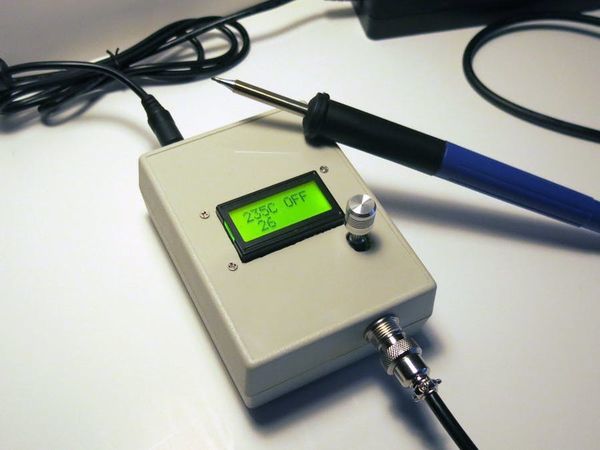
Soldering Iron Controller for Hakko T12 Tips on Arduino
"How to build your own soldering iron controller for amazing Hakko T12 tips. Story First, there was an idea When I was surfing the Internet for interesting projects, the handmade soldering station project touched me very much. The project, at the same time, was not really complicated, well-documented and very useful. I used a generic soldering iron without any controller and could not imagine the difference between the generic iron and this one. So it was brilliant idea to create own controller to try it out. " [...]

Automated Light for Better Sleeping Habits, Or: My Baby is a Great Excuse for Playing With My Gadgets
"It has been quite a long time since I have written a post on this blog. The main reason is the free time I have, or haven't, since my baby daughter was born 9 months ago. Nevertheless I keep making fun project, just have less time to document them - But I keep taking photos and videos of everything I do so eventually it WILL be documented here on the blog. Intro So lets talk about a really short and easy project - two hours max - I guarantee! The idea came when my SO and I have decided to try improving our baby daughter sleeping habits. We tried many things, where one of the suggestions (by a professional in the field) was to get a timer-controlled night light, which will be off during the night and will be automatically turned on in the morning at a pre-defined time." [...]
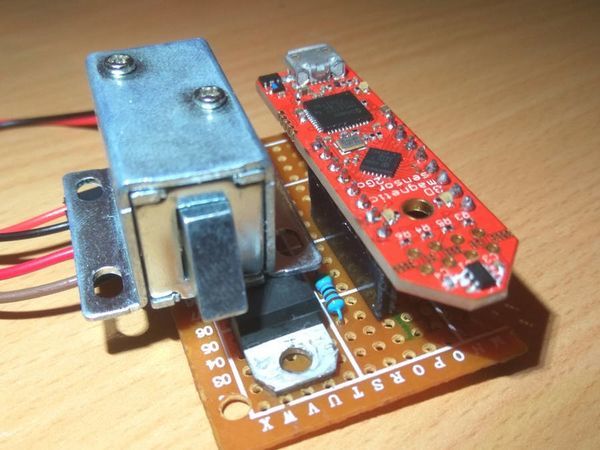
Hidden Door Lock for Smart Buildings
"Unlock doors in a building by rotating a simple magnet! Story Abstract Locks protect our buildings. There are good locks, bad locks, but a quite common thing is that they usually have a keyhole that anyone can easily access. Robbers often exploit this when they break into your house. Picking a lock is an art among them. I want to help you with this issue by removing the keyhole from your door!" [...]

Lightning detector
"Is a storm on its way? Let’s find out using a circuit based on a sensor to detect electrical shock in the atmosphere capable of letting us know how near and how strong it is. Meteorological centers can monitor, besides atmospheric parameters in order to estimate rain probability and volume, also storms and their related electrostatic phenomena, such as lightnings. In some countries exposed to consistent electrical atmospheric phenomena in their risks, this becomes particularly important. Without making any reference to the word of cinema, where catastrophic movies with “killer” lightnings are not lacking, we can understand how lightnings we see crossing the sky and hitting the ground could be dangerous, due to the huge amount of energy they can transmit eet coming from the sky (where they are formed) and crashing to the ground, on buildings, trees and unfortunately even on humans. Such danger is even higher in those areas where lightnings can form even in the near absence of storms, out of the blue." [...]
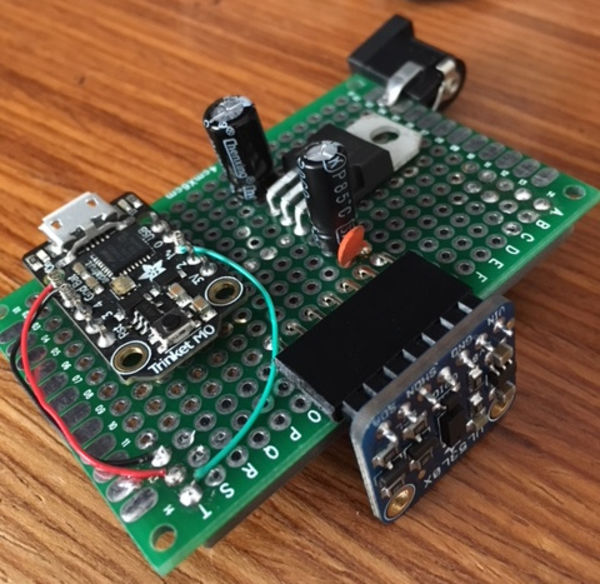
Proximity Based Lighting
"Have lights react when something gets close. Useful or spooky? You decide. I stumble out to my cafe area (originally designed to be a dining area, I’m sure) first thing each morning to make coffee. As I step up to the counter, a localized spotlight turns on so I can see what I’m doing, even though the overhead light is behind me so that the counter where I’m working is in my shadow. That’s done by the smarthome node that handles the cafe area." [...]
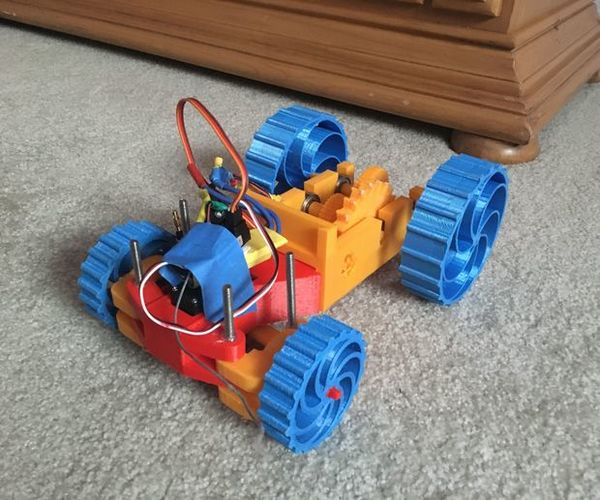
Modular 3D Printed Car
"For my Christmas, I 3D printed my brother the Flutter Scout car. It is a remote control car that is entirely 3D printed. The following link has it's GitHub page with its parts and information about it: https://github.com/tlalexander/Flutter-Scout. This car was the inspiration for my project. The problem with this car was my middle school brother with ADD did not have the attention span to put it together and he could not keep track of all the parts. So I look for other models that had easier assembly." [...]
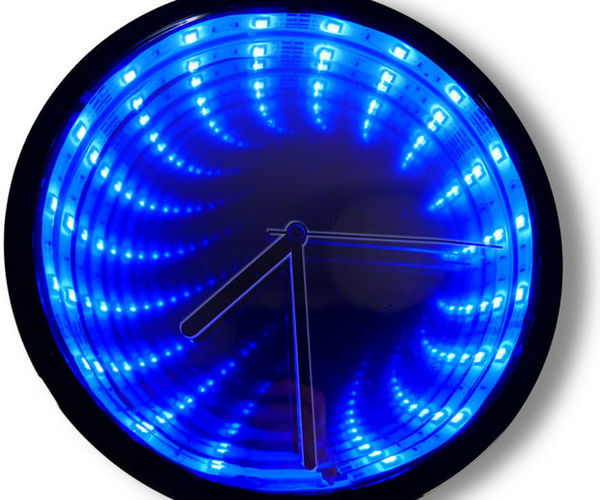
Infinity Illusion Mirror Clock
"Create the illusion of infinity thanks to mirrors and leds. Requirements: - 1 Clock - 1 Round mirror - The diameter must be the same than the inner diameter of the clock - Some One way mirror film - 1 Led strip - It can be either fixed color or RGB - 1 Glass and mirror drill bit - Drill - Screw driver - Sponge and water" [...]

Bluetooth Back-lit Display Shelf
"This shelf features 2 glass shelves, behind which lay strips of LEDs that can be controlled using an android phone and the app I wrote. They can be set to any RGB color combination, as well as several moving color patterns. I'm a complete novice when it comes to wood working and arduino, but I recently became extremely interested in both, so I decided to do this as a first project to try out both both! " [...]

An IOT air quality monitor based on the NRF52832 BLE SOC
"Do you sometimes wonder how polluted the air inside your house is? Our surroundings are constantly degrading, and there are innumerable disease that can be caused by living in unhealthy, impure and polluted surroundings. I know there are a number of devices in the market that will measure the concentration of harmful pollutants in your house. But, I decided to build one so, I get to choose the functionality I want. In this article, I will show you how to build your own air quality monitor, which will measure the concentration of standard pollutant particles(PM0.1, PM2.5, PM10) in your house, as well as the temperature and humidity. We will make it super convenient by sending the obtained data to Adafruit cloud server, so that, you can access it whenever and from where ever you want through the dashboard." [...]
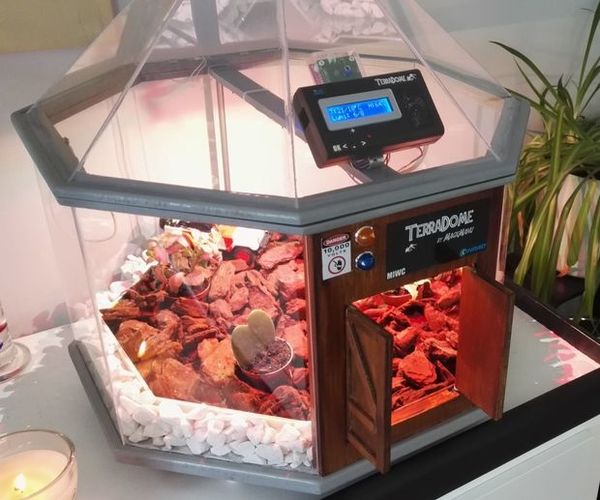
TerraDome : Mini Tropical Greenhouse With Arduino
"TerraDome is an indoor greenhouse for plants and tropical flowers shaped octagonal dome. It is driven by an Arduino Mega that regulates temperature and lighting through different sensors and an LCD display. It also has doors to the Jurassic Park (or Jurassic World) that opens when the temperature is too high in the greenhouse. " [...]

IOT123 - I2C PCB Rails
"Where durable casings are not needed, the ASSIMILATE IOT NETWORK SENSORS and ACTORS can stack more efficiently and with less resources and effort, straight onto minimalist rails. The encasing cylinders can be used (as shown in this build) or the underlying bricks can be plugged in directly. The two components are: A Primary Rail which has male headers for the D1M WIFI BLOCK (or a D1 Mini with the headers applied correctly) and a single socket for a IOT123 BRICK or an ASSIMILATE SENSOR / ACTOR. This includes the pullup resistors for the I2C lines. A Secondary Rail with 2 Sockets. These can be daisy chained, and if using IOT123 BRICKS only, extra sockets can be added to each PCB.The mounting and joining of the PCBs is entirely customizable, though I have provided simple examples." [...]

ESP8266 Screen Set WiFi Credentials
"Transfer data (WiFi credentials) from your smartphone to an ESP8266 by Pulsing your Smartphone Screen ESP8266 Screen Set WiFi Credentials Transfer data (WiFi credentials) from your smartphone to an ESP8266 by Pulsing your Smartphone Screen To setup your WiFi Credentials put your ESP12F over a Smartphone screen, and let the Black and White Oscillation transmit the information. Note: You need to cover the LDR, in a way no light can enter. The LDR should not touch the screen, it needs stay some millimeters far from the screen. Items required: - ESP-12F (and all the basic componentes to make it work) - Resistor 300k - LDR 50K-50M Omhs (GL5539) - Unzip the library ESP8266-screenSetWifi-master (attached in this projet) into your Arduino Library Folder PS: You can try other variations of resistor values and LDR types. Just make sure the max resistive value of LDR is greater than the pull-down resistor. " [...]

SPCPM (Solar Powered City Pollution Monitor)
"Low maintenance, high output air pollution, sound pollution that put throughout the city without wiring. Smart Cities Need Air Quality Sensing and Noise Sensing Air quality and noise pollution throughout the city has always been hard to measure, mainly due to maintenance for sensors all across the city. With this guide, we can build air quality sensor and sound sensor that self maintaining through solar power. Making it easy and simple to place it across the city and collect data via Helium IoT Hub. Inspiration Air quality throughout the city has always been hard to measure, solar air quality monitor uses air quality sensor attaching to the solar panel to monitor the air quality throughout the city. " [...]

IoT Made Ease: ESP-MicroPython-MQTT-ThingSpeak
"In my previous tutorial, MicroPython on ESP using Jupyter, we learned how to install and run MicroPython on an ESP device. Using Jupyter Notebook as our development environment, we also learned how to read from sensors (Temperature, Humidity, and Luminosity), We use several communication protocols and methods, Analog, Digital, 1-Wire and I2C, this last one to display our captured data on an OLED display. Now, on this tutorial using an MQTT protocol, we will get all captured data, sending them to an IoT service, ThingSpeak.com and to a mobile App (Thingsview), where we can log and play with data. " [...]
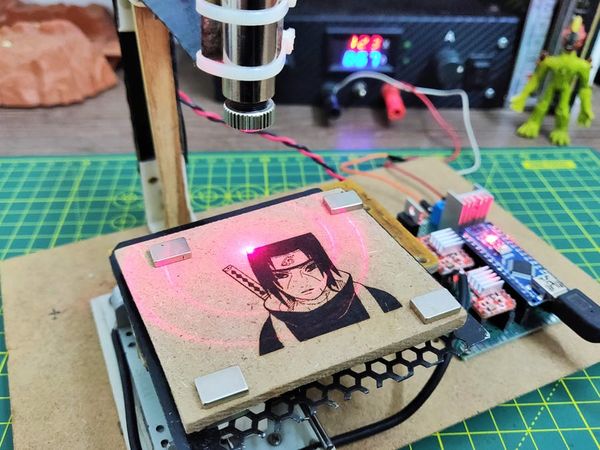
Mini CNC Laser Wood Engraver and Laser Paper Cutter
"I made an Arduino-based laser CNC wood engraver and thin paper cutter using old DVD drives, 250mW laser. Playing area is 40mm x 40mm max. This is an tutorials on how I made an Arduino-based CNC laser wood engraver and thing paper cutter using old DVD drives and a 250mW laser. Playing area is 40mm x 40mm max. Isn't it fun making a own machine out of old things? Step 1: Parts and Materials Required Arduino Nano (with usb cable) 2x DVD drive stepper mechanism 2x A4988 stepper motor driver modules (or GRBL shield) 250mW Laser with adjustable lens (or above) 12v 2Amps power supply minimum 1x IRFZ44N N-CHANNEL Mosfet 1x 10k resistor 1x 47ohm resistor 1x LM7805 voltage regulator (with heatsink) Blank PCB Board Male and Female Headers 2.5mm JST XH-Style 2pin male connector 1x 1000uf 16v capacitor Jumper cables 8x small neodymium magnets ( which I have salvaged from DVD lens mechanism) 1x 2pin plug in screw terminal block connector Zip ties (100mm) Super Glue Epoxy Glue Wooden plyboard Acrylic sheet Some M4 screws, bolts and nuts Laser Safety Glasses LASER SAFETY GLASSES are must needed in this project." [...]
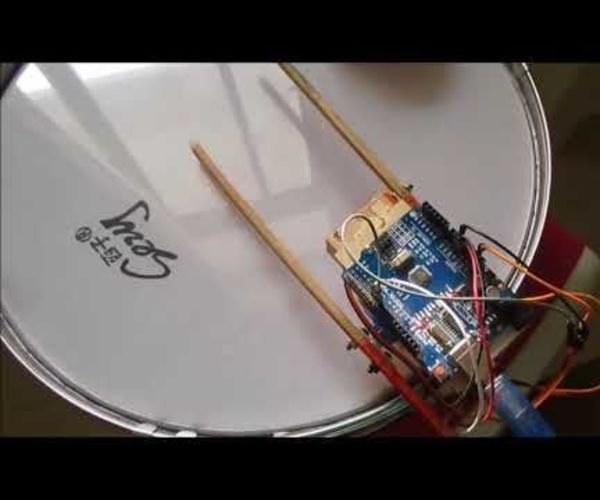
Arduino Servo Drum Machine
"This is a simple two micro-servo and Arduino Uno controlled drum machine or robot. The servos are mounted on an L-shaped bracket of wood that is held to the snare drum with 4 strong magnets. The servo arms are bolted to two chopsticks which serve as the drum-sticks. It is quite loud but not too loud. Much louder hits could be obtained by using standard size servos and real drum-sticks which are quite a bit heavier. But that would also require a separate power supply for the servos." [...]

RFID Security System With LCD 1602
"IntroductionToday we will be making an RFID Security System. This will work like a security system so when an RFID tag or card is near it will display a message on the LCD 1602. The purpose of this project is to simulate how RFID door locks work. So, it will work when an RFID tag or card is near the RFID Reader, it will detect the card or tag and display a message on the LCD. " [...]

CPU and RAM Usage Monitor
"Story Character LCDs are one of the most common things one gets in an Arduino kit. They are very cheap and fun to work with. They are categorized in two categories: one that is directly hooked up to the Arduino board, and another that uses an I2C module between LCD and the main board. In this project, I've used one with pre-soldered I2C module to minimize the number of wires. Instructions Wire up the components using the schematic below. Upload the code mentioned below to your Arduino Nano/Uno." [...]
That's all Folks!


